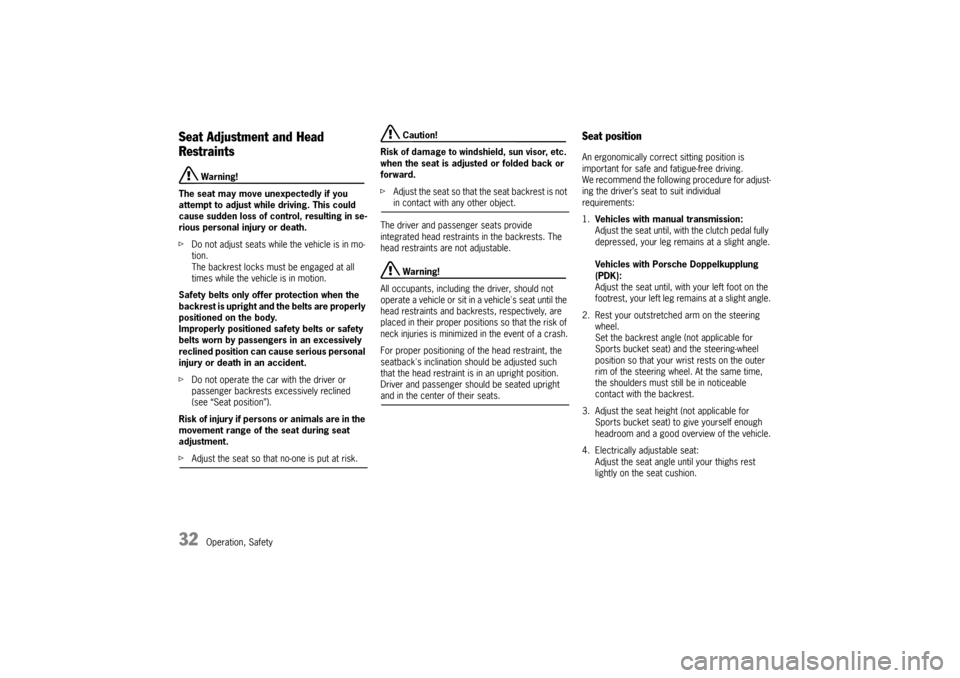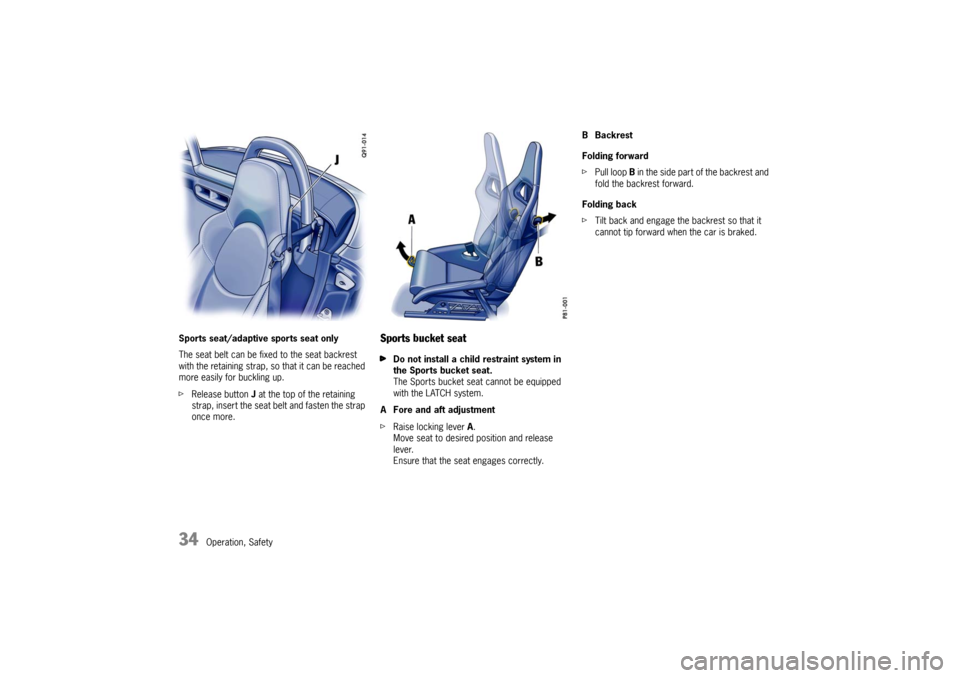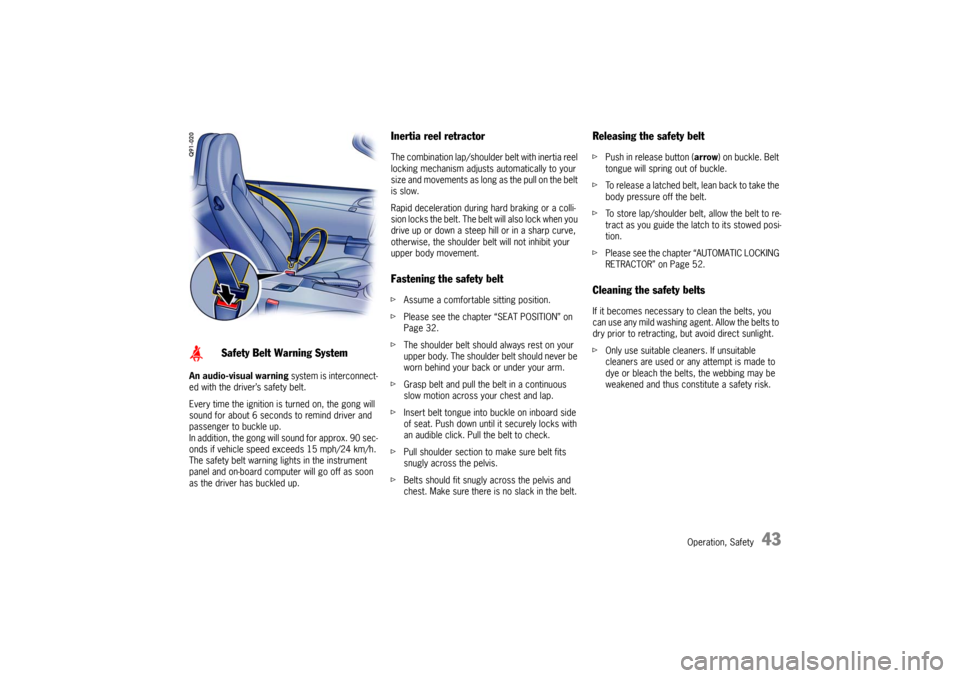2010 PORSCHE BOXSTER S belt
[x] Cancel search: beltPage 4 of 294

2Dear Owner, We would like to thank you for your purchase of a
Porsche Sports car.
Judging by the car you have chosen, you are a mo-
torist of a special breed, and you are probably no
novice when it comes to automobiles.
Remember however, as with any vehicle, you
should take time to familiarize yourself with your
Porsche and its performance characteristics. Al-
ways drive within your own unique capabilities as
a driver and your level of experience with your
Porsche. Ensure that anyone else driving your
Porsche does the same. To prevent or minimize in-
jury, always use your safety belts. Never consume
alcohol or drugs before or during the operation of
your vehicle.
This Owner’s Manual contains a host of useful in-
formation. Please take the time to read this manu-
al before you drive your new Porsche. Become fa-
miliar with the operation of your Porsche car for
maximum safety and operating pleasure. The bet-
ter you know your Porsche, the more pleasure you
will experience driving your new car.
Always keep your Owner’s Manual in the car, and
give it to the new owner if you ever sell your
Porsche. A separate Maintenance Booklet
explains how
you can keep your Porsche in top driving condition
by having it serviced regularly.
A separate Warranty and Customer Informa-
tion Booklet contains detailed information about
the warranties covering your Porsche.
For U.S. only:
If you believe that your vehicle has a fault which
could cause a crash, injury or death, you should
immediately inform the National Highway Traffic
Safety Administration (NHTSA) in addition to noti-
fying Porsche Cars North America, Inc. (Porsche
Cars N.A.).
If NHTSA receives similar complaints, it may open
an investigation, and if it finds that a safety prob-
lem exists in a group of vehicles, it may order a re-
call and remedy campaign. However, NHTSA can-
not become involved in individual problems be-
tween you and your dealer, or Porsche Cars N.A..
To contact NHTSA, you may call the Vehicle Safety
Hotline toll-free at 1-88 8-327-4236 (TTY: 1-800-
424-9153); go to http://www.safercar.gov; or
write to: Administrator, NHTSA, 400 Seventh
Street, SW., Washington, DC 20590.
You can also obtain other information about motor
vehicle safety from http://www.savercar.gov.
Your car has thousands of parts and components
which have been designed and manufactured in
accordance with Porsche’s high standards of
engineering quality and safety.
Warning!
Any alteration or misuse of the vehicle can
lead to accidents and severe or fatal
personal injuries.
Any alteration of the vehicle may negate or
interfere with those safety features built into
the vehicle. Modifications may be carried out
on your vehicle only if approved by Porsche.
Your Porsche is intended to be used in a safe
manner obeying the local laws and in the
light of driving conditions faced by you, and
in accordance with the instructions provided
in this Owner’s Manual.
f Do not misuse your Porsche by ignoring those
laws and driving conditions, or by ignoring the instructions in this manual. Caution!
The fitting of racing tires (e.g. slicks) for
sporting events is not approved by Porsche.
Very high cornering speeds can be achieved
with racing tires. However, the resulting
transverse acceleration values would jeopar-
dize the adequate supply of oil to the engine.
Porsche therefore will not accept any
warranty or accept any liability for damage
occurring as a result of non-compliance with
this provision.
f Do not fit racing tires (e .g. slicks) for sporting events on your vehicle.
Page 8 of 294

6
Table of ContentsTable of ContentsPorsche Ceramic Composite Brake (PCCB) ...... 4
Setting and operating vehicle components
when driving .................................................. 4
Portable Fuel Contain ers ................................ 4
Ground Clearance ...... .................................... 4
Engine Exhaust .......... .................................... 5Before driving off................................. 8Before driving off... ........................................ 8
Break in hints for the first
2,000 miles/3,000 kilo meters ...................... 10Operation, Safety ............................... 13Keys ........................ .................................. 15
Security Wheel Bolts .................................... 15
Doors ................................................ ......... 18
Central Locking in Cars without Alarm System 19
Central Locking in Cars with Alarm System ... 21
Alarm System,
Passenger Compartment Monitoring ............. 25
Power Windows ............. .............................. 27
Mirrors ...................... .................................. 29
Rear Window Defogger, Door Mirror Heating .. 31
Seat Adjustment and Head Restraints ............ 32
Seat Memory ............. .................................. 35
Heated Seats ............ .................................. 37
Seat Ventilation ...... ...................................... 38
Steering Wheel Adjust ment ........................... 38
Steering Wheel Heatin g ................................ 39
Multi-Functional Steering Wheel ..................... 40 Sun Visors ...............
....................................41
Safety Belts ............. ....................................42
Airbag Systems ....... ....................................44
Child Restraint System s ................................50
LATCH System
Child seat bracket on the passenger’s seat ....54
Sports Exhaust System ................................55
Parking Brake .......... ....................................55
Brakes ................... ....................................56
ABS Brake System (Antilock Brake System) ...59
Clutch Pedal ................ ................................60
Sport Mode ................. ................................61
Porsche Stability Manage ment (PSM) .............63
Porsche Active Suspension Management
(PASM) ........................ ................................66
Retractable Spoiler .. ................................... 67
Fixed rear spoiler . ........................................68
Interior lights ................................ ...............69
Parking Aids ........... ....................................70
Ignition/Starter Switch with
anti-theft Steering Lo ck .................................72
Starting Procedures .....................................75
Stopping Engine .. ........................................76
Emergency Flasher Swit ch ............................77
Light Switch on Vehicles
with Bi-Xenon Headlig hts ...............................78
Light Switch on Vehicles
with Halogen Headlights ...............................80
Turn Signal / Headlight Dimmer /Parking light /
Flasher Lever ........... ....................................81
Windshield Wiper/ Washer Lever ...................82
Automatic Speed Contro l ..............................
84Cupholder ...................
................................ 86
Ashtray ....................... ................................ 87
Cigarette Lighter .... ..................................... 88
Storage in the Passenger Compartment ........ 89
Luggage Storage on Engine Compartment Lid 91
Luggage Compartment Li ds ......................... 92
Luggage Compartment ................................ 94
Rear luggage compartm ent .......................... 94
Trunk Entrapment .. ..................................... 95
Porsche Communication Management (PCM) . 97
Car Telephone and Aftermarket Alarms ........ 99
iPod, USB and AUX . ................................... 100
Fire Extinguisher .... ................................... 101
HomeLink ................... .............................. 102
Automatic Air Conditioning System,
Heated Rear Window/
Door Mirror Heating. ........................ 105Air Conditioning ...... ................................... 106
Automatic Air Conditioning System ............. 109
Central and Side Vents ............................. 112
Fresh-air Intake . ....................................... 112
Heated Rear Window/Door Mirror Heating ... 113Instruments, On-Board Computer,
Warnings ........................................ 115Instrument Panel USA Models ..................... 116
Instrument Panel Canada Models ................ 118
Automatic Speed Control Indicator light ...... 120
Instrument Illumination ............................... 120
Page 11 of 294

Before driving off...
9
In the driver’s seat... fCheck operation of the horn.
f Position seat for easy reach of foot pedals and
controls.
To reduce the possibility of injury from the
airbag deployment, you should always sit back
as far from the steering wheel as is practical,
while still maintaining full vehicle control.
f Adjust the inside and outside rear view mirrors.
f Buckle your safety belts.
f Check operation of the foot and parking brake.
f Check all warning and indicator lights with
ignition on and engine not running.
f Start engine and check all warning displays for
warning symbols.
f Never leave an idling car unattended.
f Lock doors from inside, especially with chil-
dren in the car to prevent inadvertent opening
of doors from inside or outside.
Drive with doors locked.
On the road... fNever drive after you have consumed alcohol
or drugs.
f Always have your safety belt fastened.
f Always drive defensively.
Expect the unexpected.
f Use signals to indicate turns and lane changes.
f Turn on headlights at dusk or when the driving
conditions warrant it.
f Always keep a safe distance from the vehicle in
front of you, depending on traffic, road and
weather conditions.
f Reduce speed at night and during inclement
weather.
Driving in wet weather requires caution and re-
duced speeds, particularly on roads with
standing water, as the handling characteristics
of the vehicle may be impaired due to hydro-
planing of the tires.
f Always observe speed limits and obey road
signs and traffic laws.
f When tired, get well off the road, stop and take
a rest. Turn the engine off. Do not sit in the ve-
hicle with engine idling.
Please see the chapter “ENGINE EXHAUST” on
Page 5. f
When parked, always set the parking brake.
Move the PDK selector le ver to ”P“ or the gear-
shift lever to reverse or first gear.
On hills also turn the front wheels toward the
curb.
f When emergency repairs become necessary,
move the vehicle well off the road. Turn on the
emergency flasher and use other warning de-
vices to alert other motorists. Do not park or
operate the vehicle in areas where the hot ex-
haust system may come in contact with dry
grass, brush, fuel spill or other flammable ma-
terial.
f Make it a habit to have the engine oil checked
with every refueling.
Page 15 of 294

Operation, Safety
13
Operation, Safety
Keys ........................
.................................. 15
Security Wheel Bolts .................................... 15
Doors ................................................ ......... 18
Central Locking in Cars without Alarm System 19
Central Locking in Cars with Alarm System ... 21
Alarm System,
Passenger Compartment Monitoring ............. 25
Power Windows ............. .............................. 27
Mirrors ...................... .................................. 29
Rear Window Defogger, Door Mirror Heating .. 31
Seat Adjustment and Head Restraints ............ 32
Seat Memory ............. .................................. 35
Heated Seats ............ .................................. 37
Seat Ventilation ...... ...................................... 38
Steering Wheel Adjust ment ........................... 38
Steering Wheel Heatin g ................................ 39
Multi-Functional Steering Wheel ..................... 40
Sun Visors ................. .................................. 41
Safety Belts ............... .................................. 42
Airbag Systems ......... .................................. 44
Child Restraint System s ............................... 50
LATCH System
Child seat bracket on the passenger’s seat .... 54
Sports Exhaust System ................................ 55
Parking Brake ............ .................................. 55
Brakes ..................... .................................. 56
ABS Brake System (Antilock Brake System) ... 59
Clutch Pedal .............. .................................. 60
Sport Mode ............... .................................. 61
Porsche Stability Mana gement (PSM) ............. 63
Porsche Active Suspension Management
(PASM) ...................... .................................. 66 Retractable Spoiler ..
................................... 67
Fixed rear spoiler . ........................................ 68
Interior lights ................................ ............... 69
Parking Aids ........... .................................... 70
Ignition/Starter Switch with
anti-theft Steering Lo ck ................................ 72
Starting Procedures ..................................... 75
Stopping Engine . ........................................ 76
Emergency Flasher Swit ch ............................ 77
Light Switch on Vehicles
with Bi-Xenon Headlights ............................... 78
Light Switch on Vehicles
with Halogen Headlights ............................... 80
Turn Signal / Headlight Dimmer /Parking light /
Flasher Lever ........... .................................... 81
Windshield Wiper/ Wash er Lever ................... 82
Automatic Speed Control .............................. 84
Cupholder ................... ................................
86
Ashtray ....................... ................................ 87
Cigarette Lighter ...... .................................... 88
Storage in the Passenger Compartment ........ 89
Luggage Storage on Engine Compartment Lid 91
Luggage Compartment Li ds .......................... 92
Luggage Compartment ................................ 94
Rear luggage compartm ent .......................... 94
Trunk Entrapment ... .................................... 95
Porsche Communication Management (PCM) .. 97
Car Telephone and Aftermarket Alarms ......... 99
iPod, USB and AUX .. .................................. 100
Fire Extinguisher .. ...................................... 101
HomeLink .................... .............................. 102
Page 34 of 294

32
Operation, Safety
Seat Adjustment and Head
Restraints
Warning!
The seat may move unexpectedly if you
attempt to adjust while driving. This could
cause sudden loss of control, resulting in se-
rious personal injury or death.
f Do not adjust seats while the vehicle is in mo-
tion.
The backrest locks must be engaged at all
times while the vehicle is in motion.
Safety belts only offer protection when the
backrest is upright and the belts are properly
positioned on the body.
Improperly positioned sa fety belts or safety
belts worn by passengers in an excessively
reclined position can cause serious personal
injury or death in an accident.
f Do not operate the car with the driver or
passenger backrests excessively reclined
(see “Seat position”).
Risk of injury if persons or animals are in the
movement range of the seat during seat
adjustment.
f Adjust the seat so that no-one is put at risk.
Caution!
Risk of damage to windshield, sun visor, etc.
when the seat is adjusted or folded back or
forward.
f Adjust the seat so that the s e a t b a c k re s t i s n o t in contact with any other object.
The driver and passenger seats provide
integrated head restraints in the backrests. The
head restraints are not adjustable. Warning!
All occupants, including the driver, should not
operate a vehicle or sit in a vehicle's seat until the
head restraints and backrests, respectively, are
placed in their proper posi tions so that the risk of
neck injuries is minimize d in the event of a crash.
For proper positioning of the head restraint, the
seatback's inclination should be adjusted such
that the head restraint is in an upright position.
Driver and passenger should be seated upright
and in the center of their seats.
Seat positionAn ergonomically correct sitting position is
important for safe and fatigue-free driving.
We recommend the following procedure for adjust-
ing the driver’s seat to suit individual
requirements:
1. Vehicles with manual transmission:
Adjust the seat until, with the clutch pedal fully
depressed, your leg remains at a slight angle.
Vehicles with Porsche Doppelkupplung
(PDK):
Adjust the seat until, with your left foot on the
footrest, your left leg remains at a slight angle.
2. Rest your outstretched arm on the steering wheel.
Set the backrest angle (not applicable for
Sports bucket seat) and the steering-wheel
position so that your wr ist rests on the outer
rim of the steering wheel. At the same time,
the shoulders must still be in noticeable
contact with the backrest.
3. Adjust the seat height (not applicable for
Sports bucket seat) to give yourself enough
headroom and a good overview of the vehicle.
4. Electrically adjustable seat: Adjust the seat angle until your thighs rest
lightly on the seat cushion.
Page 36 of 294

34
Operation, Safety
Sports seat/adaptive sports seat only
The seat belt can be fixed to the seat backrest
with the retaining strap, so
that it can be reached
more easily for buckling up.
f Release button J at the top of the retaining
strap, insert the seat be lt and fasten the strap
once more.
Sports bucket seatf Do not install a child restraint system in
the Sports bucket seat.
The Sports bucket seat cannot be equipped
with the LATCH system.
A Fore and aft adjustment
f Raise locking lever A.
Move seat to desired position and release
lever.
Ensure that the seat engages correctly. BBackrest
Folding forward
f
Pull loop B in the side par t of the backrest and
fold the backrest forward.
Folding back
f Tilt back and engage the backrest so that it
cannot tip forward when the car is braked.
Page 44 of 294

42
Operation, Safety
Safety Belts
Warning!
Always make sure your and your passenger’s
safety belts are properly fastened while the
vehicle is in motion.
Failure to follow safety belt warnings may re-
sult in serious personal injury or death.
f For your and your passenger’s protection, use
safety belts at all times while the vehicle is in
motion.
f Use appropriate child restraint systems for all
small children.
Proper wearing of safety belts
f S a f e t y b e l t s m u s t b e p o s i t i o n e d o n t h e b o d y a s
to restrain the upper body and lap from sliding
forward. Improperly positioned safety belts
can cause serious personal injury or death in
case of an accident.
f The shoulder belt should always rest on your
upper body. The shoulder belt should never be
worn behind your back or under your arm.
f For maximum effectiveness, the lap belt
should be worn low across the hips.
f Pregnant women should position the belt as
low as possible across the pelvis. Make sure it
is not pressing against the abdomen. f
Belts should not be worn twisted.
f Do not wear belts over rigid or breakable ob-
jects in or on your clothing, such as eye glass-
es, pens, keys, etc. as these may cause injury.
f Several layers of heavy clothing may interfere
with proper positioning of belts.
f Belts must not rub against sharp objects or
damage may occur to the belt.
f Two occupants should never share the same
belt at the same time.
Care and maintenance
f Keep belt buckles free of any obstruction that
may prevent a secure locking.
f Belts that have been subjected to excessive
stretch forces in an accident must be inspect-
ed or replaced to ensure their continued effec-
tiveness in restraining you.
The same applies to belt tensioner systems
which have been triggered.
In addition, the anchor points of the belts
should be checked.
f If safety belts do not work properly, see your
authorized Porsche dealer immediately.
f I f t h e b e l t s s h o w d a m a g e t o w e b b i n g , b i n d i n g s ,
buckles or retractors, they should be replaced
to ensure safe operation.
f Do not modify or disasse mble the safety belts
in your vehicle. f
The belts must be kept clean or the retractors
may not work properly.
Please see the chapter “CAR CARE INSTRUC-
TIONS” on Page 213.
f Never bleach or dye safety belts.
f Do not allow safety belts to retract until they
are completely dry after cleaning or this may
cause damage to the belt.
Belt tensioner Depending on the force of an impact, fastened
safety belts are tightened in an accident.
The belt tensioners are triggered in:
– Front, side and rear impacts of sufficient
severity.
– In cases of vehicle rollover.
Note
The belt-tensioner system can be triggered only
once; the system must be replaced afterward.
If there is a fault in the belt-tensioner system, the
airbag warning light lights up.
Work may be performed on the belt-tensioner sys-
tem only by an authorized Porsche dealer.
Smoke is released when the belt tensioners are
triggered. This does not indicate a fire in the
vehicle.
Page 45 of 294

Operation, Safety
43
An audio-visual warning system is interconnect-
ed with the driver ’s safety belt.
Every time the ignition is turned on, the gong will
sound for about 6 seconds to remind driver and
passenger to buckle up.
In addition, the gong will sound for approx. 90 sec-
onds if vehicle speed exceeds 15 mph/24 km/h.
The safety belt warning lights in the instrument
panel and on-board computer will go off as soon
as the driver has buckled up.
Inertia reel retractor The combination lap/shoulder belt with inertia reel
locking mechanism adjusts automatically to your
size and movements as long as the pull on the belt
is slow.
Rapid deceleration during hard braking or a colli-
sion locks the belt. The belt will also lock when you
drive up or down a steep hill or in a sharp curve,
otherwise, the shoulder belt will not inhibit your
upper body movement.Fastening the safety beltf Assume a comfortable sitting position.
f Please see the chapter “SEAT POSITION” on
Page 32.
f The shoulder belt should always rest on your
upper body. The shoulder belt should never be
worn behind your back or under your arm.
f Grasp belt and pull the belt in a continuous
slow motion across your chest and lap.
f Insert belt tongue into buckle on inboard side
of seat. Push down until it securely locks with
an audible click. Pull the belt to check.
f Pull shoulder section to make sure belt fits
snugly across the pelvis.
f Belts should fit snugly across the pelvis and
chest. Make sure there is no slack in the belt.
Releasing the safety beltf Push in release button (arrow ) on buckle. Belt
tongue will spring out of buckle.
f To release a latched belt, lean back to take the
body pressure off the belt.
f To store lap/shoulder belt, allow the belt to re-
tract as you guide the latch to its stowed posi-
tion.
f Please see the chapter “AUTOMATIC LOCKING
RETRACTOR” on Page 52.Cleaning the safety beltsIf it becomes necessary to clean the belts, you
can use any mild washing agent. Allow the belts to
dry prior to retracting, but avoid direct sunlight.
f Only use suitable cleaners. If unsuitable
cleaners are used or any attempt is made to
dye or bleach the belt s, the webbing may be
weakened and thus constitute a safety risk.
Safety Belt Warning System